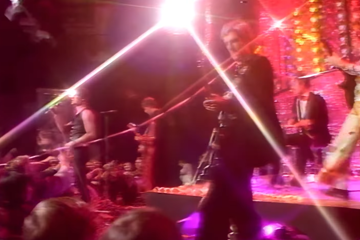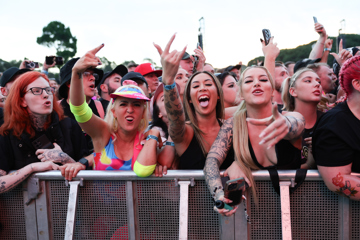Sure There's No 'Let It Go', But The 'Frozen' Sequel Still Delivers
"'Frozen II' is — surprisingly, for a work of pure 3D computer animation — a handsome visual work."
Early in Frozen II, an opening-act scene finds the familiar friends from the most successful animated film of all time back on screen, and back together, playing a game of charades. The clue that the feisty, fiery Anna is trying — and failing — to convey to her sister, ice queen (like, literally) Elsa, is ‘villain’. It feels like a notable nod from the filmmakers, Chris Buck and Jennifer Lee, given that the movie doesn’t feature a standard villain or antagonist.
This feels like addressing a flaw from the first film, which for all its bounteous box office and soundtrack success — and for its cultural phenomenon status, so evident to anyone who attended a child’s birthday party between 2014-2016 — still came with a cut-rate villain. It was a love interest revealed, in a second act turn that’s mocked herein, to be a duplicitous schemer, out to seize power from our princess sisters in devilish, murderous fashion. I mean, after all, what’s a Disney movie without an evil villain?
Turns out, it’s way more interesting finding people grappling with things beyond some mere (first bad) man or wizened witch. This time around, Anna and Elsa must front up to forces greater than the individual, be they ecological or sociological. Causing (climate) catastrophe in their storybook kingdom of Arendelle, they must deal with the personification of the very elements of nature: earth (giant rock monsters), air (a zippy zephyr of blown leaves), fire (a Pokémon-like gecko), water (a pre-teen girl courting galloping horse made from water). More interestingly, they’re also dealing with the dark tragedy of history, things that happened, in their name, before their birth/s.
Beckoned by a distant siren song, a voice calling from beyond the enchanted forest — provided by Norwegian alt-pop starlet Aurora, who literally lives on a fjord — our gang set out on the standard overland adventure with wacky sidekicks and side plots and new revelations.
Their mission in search of the hidden truth, and what they discover is eco-tinged, but really a parable for coming to terms with, and making amends for, the horrors of a colonial past. The peaceful thrones upon which the sisters sit, it turns out, are the product of the generations-ago displacement and killing of native peoples; a dark reality that demands contemporary atonement. Which is a pretty amazing lesson to be smuggled within a family friendly animated musical starring a talking snowman.
Don't miss a beat with our FREE daily newsletter
That talking snowman is the film’s great source of humour, from slapstick to gonzo to absurdly philosophical. In Frozen, said snowman, Olaf (voiced by Josh Gadd) was coming to terms with what it meant to have come to life. In Frozen II, he’s trying to grapple with the ramifications of his sentience. Though he still acts like a toddler (boundlessly enthusiastic about everything, especially reciting endless facts about nature on long car(t) rides) he sounds a lot, a times, like a first-year philosophy student, mind blown by the deeply existential nature of existence. A great gag for the adults wrangling real life toddlers of their own is Olaf’s sure determination that, when you get older, everything must just make sense.
Olaf is also given Frozen II’s best joke, in which, encountering both a troop of soldiers and a tribe of natives who’ve been trapped in the enchanted forest for decades, he re-enacts the entire plot of the first movie. It’s one of numerous meta-movie moments herein, and one that allows Buck and Lee to mock what’s come before. They do that again in a scene in which Elsa pirouettes through a glittering temple of memories, where the past returns to life in snowy frescos and icy figures, and she comes face to face with herself belting out Let It Go, and flinches with revulsion.
There’s no song herein that’s likely to be so culturally inescapable as Let It Go, but there’s some notable numbers, from a scene-setting ensemble-sung opener, Some Things Never Change, about the yearning for constancy in the face of the inevitability of change, to a piano-balladic torch song, Show Yourself, depicted in a veritable Disney On Ice routine. In less showstopper-ish fashion, earnest, Steve Irwin-haircut’d lumberjack Kristoff (Jonathan Groff, who’ll forever be star of Looking to me) gets to belt out a wry soft-metal power ballad that has musical shades of Peter Cetera’s The Glory Of Love from Karate Kid 2 and visual shades of a karaoke machine’s stock footage.
The best animated setting for a musical number comes when our Snow Queen is lost in a stylised blackness, surrounded by a host of psychedelic images, twirling through a metaphysical screensaver that feels hallucinatory. It’s an inspired reminder of the wonders of traditional stylised animation in the face of the horrors of Lion King-styled photorealism: an artistic rendering of a character’s internal state, and the shimmering vistas of her memory, imagination, and sense of wonder. Otherwise, Frozen II is — surprisingly, for a work of pure 3D computer animation — a handsome visual work; featuring an autumnal palette of oranges, browns, and reds, this seasonal setting an evocation of the film’s deep, secretly existential themes.
Rather than merely being a sequel that just runs things back, this is a story of change, and the passage of time. How the past influences the present, and happy times soon are lost to the current, turned fast receding, bittersweet memories. “Do you ever worry about the notion of impermanence?” asks its talking snowman, comically, on opening. But, though it’s a joke, the sentiment lingers, trickling into all that comes thereafter.







